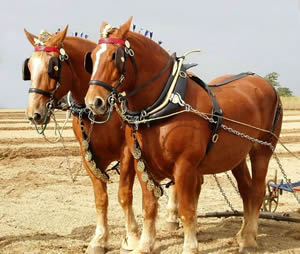History
Todays best-known breeds of draft horses are said to date back to the "Great War" horses of Medieval times. But while these great titans clashed in mortal combat, the quiet farmers of eastern England went about developing their own breed of heavy horse, the Suffolk Punch. This one breed, is today the least known to Americans, and yet has perhaps more qualities appealing to the American breeder than any of the better known breeds of draft horses.
The homeland of the Suffolk horses was Norfolk and Suffolk counties of England. It was bordered on the north, east, and south by the North Sea and on the west by the Fens. Isolated from their neighbors, the farmers of Suffolk independently developed breeds of livestock to fit their special way of life. To plow the heavy clay soil they needed an agricultural horse with not only power but stamina, health, longevity, and docility. So these fine husbandmen produced the Suffolk horse and bred into him the attributes that fulfilled their needs.
The Suffolk farmer used his horses to till and harvest his own lands, so seldom did he have horses to sell. This not only kept the Suffolk relatively unknown but also pure, remaining unchanged and true to his original purpose, to be a strong and faithful worker for his master. Of all the draft breeds, the Suffolk is one of the oldest in existence with records dating back to 1880. Crisp's horse of Ufford, the foundation stallion of the breed was foaled in 1768.
The Suffolk in North America was hard hit by the headlong mechanization of the post World War II period. Although it had made great strides in popularity during the 30s, it still did not have the numerical base necessary to withstand the onslaught of the 50s. For a few years the Association ceased to function. Then in the early 60s as the draft horse market began its recovery, the few widely scattered breeders who had kept faith with their Suffolks reorganized, holding their first meeting in 15 years in May of 1961.
The early 1970s saw some outstanding importations from England. While interest in the draft horse in general was expanding, the demand for Suffolks also began to increase. The 80s saw an encouraging increase in the number of Suffolks registered and again there were some excellent importations from England. With continuing importations and a substantial increase in the number of registered Suffolks, the 1990s have shown tremendous progress.
Behavior
The Suffolk is a horse of splendid disposition and easy temperament. He exhibits a ready willingness to work, great endurance and the quality known as "heart," the inner determination to push on. The farmer referred to this quality when he said he valued the Suffolk as "a puller of dead weight and indeed a good drawer."
Function
The Suffolk Punch was used mainly for draught work on farms but was also often used to pull heavy artillery in wartime. Like other heavy horses, they were also used to pull non-motorised vans and other commercial vehicles.[16] Today, they are used for commercial forestry operations, for other draught work, and in advertising. They are also used for crossbreeding, to produce heavy sport horses for use in hunter and show jumping competition.






